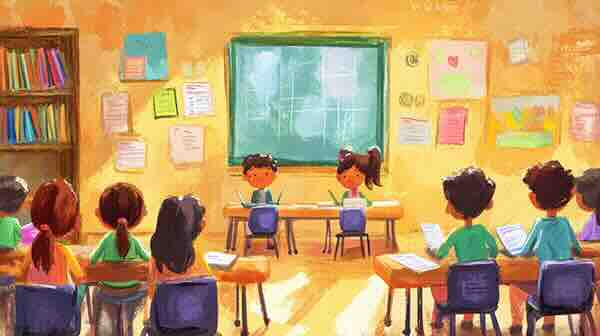Differentiating instruction in the classroom has always been a challenge. With students at various levels, abilities, and learning styles, teachers need to find ways to tailor lessons that fit each student’s needs. Traditionally, this process has been time-consuming and complex.
Enter Artificial Intelligence (AI). AI helps teachers quickly and efficiently personalize learning experiences, making it easier to meet students where they are. Here’s how AI supports differentiated instruction, with real-world examples of schools already using it.
1. Personalized Learning Paths
AI can analyze a student’s performance and create individualized learning paths. By assessing each student’s strengths and weaknesses, the system adjusts the lesson’s difficulty or introduces new material to match their needs.
For example, Montgomery County Public Schools in Maryland uses an AI-powered math platform that tracks students’ progress in real-time. If a student is excelling in fractions, the system will offer more complex problems, while a student struggling with basic multiplication will receive additional support in that area. This immediate adjustment helps both advanced and struggling students remain engaged in the lesson.
By tailoring lessons automatically, AI allows teachers to spend more time guiding and coaching rather than trying to manually differentiate for each student.
2. Automated Feedback
Providing timely feedback is key to helping students grow. AI enables teachers to give instant, automated feedback, which can significantly boost learning. When students get immediate corrections or guidance, they can adjust their thinking and improve right away.
Take New York City Public Schools, where AI tools are used to support reading comprehension. These systems analyze students’ responses to reading passages and provide instant feedback. If a student misunderstands a concept, the AI offers corrections or suggestions. Teachers can then see this data and decide how to further support individual students. This approach helps students correct mistakes in real time, preventing learning gaps from widening.
Immediate feedback keeps students on track and gives them the confidence to move forward at their own pace.
3. Adaptive Assessments
Adaptive assessments are another way AI supports differentiation. These assessments adjust their difficulty based on a student’s responses. If a student answers a question correctly, the next question might be more challenging. If they answer incorrectly, the AI presents a simpler problem.
Squirrel AI in China, a widely used AI-powered learning system, is a perfect example of this. The system assesses each student’s abilities and knowledge in subjects like math and science. Based on their performance, it provides a series of adaptive questions that align with their current level. This ensures that every student is working at the right level of difficulty—whether they need more support or more of a challenge. Teachers can then step in with personalized instruction where it’s most needed.
Adaptive assessments ensure that students aren’t overwhelmed with too-difficult material or bored with overly simple tasks.
4. Monitoring and Analyzing Classroom Participation
Another challenge teachers face is understanding which students are engaged in classroom discussions and which are not. AI tools can help track participation, giving teachers valuable data on student involvement.
TeachFX, a tool used in several schools in California, records classroom discussions and uses AI to analyze student engagement. It provides data on how much each student speaks, who dominates conversations, and which students need encouragement to participate more. Teachers can then adjust their lessons or discussion strategies to ensure that all students are involved.
This helps teachers differentiate not just the content but also the way they engage students, ensuring that quieter or less confident students are given the support they need to participate fully.
5. Individualized Support for Struggling Students
AI can help teachers identify students who are struggling and provide targeted support. Instead of waiting until a test or exam to see who’s falling behind, AI tracks student performance in real-time and flags any issues as they happen.
At Summit Public Schools in California, AI tools monitor student progress and alert teachers when students are struggling with specific concepts. For instance, if a student consistently performs poorly on certain assignments, the AI system identifies this trend and recommends additional resources or interventions. This early detection allows teachers to intervene before the student falls too far behind.
By identifying problems early, AI ensures that struggling students get the help they need before it’s too late.
6. Supporting Diverse Learning Styles
Every student learns differently. Some students are visual learners, others prefer hands-on activities, and some might excel with written instructions. AI can help tailor lessons to these diverse learning styles.
In Cedar Rapids Community School District in Iowa, teachers use AI-powered platforms that suggest different types of resources based on individual student preferences. If a student prefers video content, the AI might recommend an instructional video, while another student might receive a reading passage or an interactive simulation. This ensures that every student can access content in the way that suits them best, making learning more effective.
By catering to different learning styles, AI allows all students to engage with content in ways that feel natural to them.
Conclusion
AI is transforming differentiated instruction in classrooms by making it faster, more efficient, and more personalized. From creating individualized learning paths to offering real-time feedback, AI enables teachers to meet every student’s needs, whether they’re struggling, excelling, or somewhere in between.
Schools like Montgomery County Public Schools, New York City Public Schools, and others using tools like TeachFX and Squirrel AI show that AI can make a real difference in classrooms. As more schools adopt these technologies, the potential for AI to enhance teaching and learning will only grow. By embracing AI, teachers can ensure that every student receives the support they need to succeed, creating more equitable and personalized learning environments for all.
